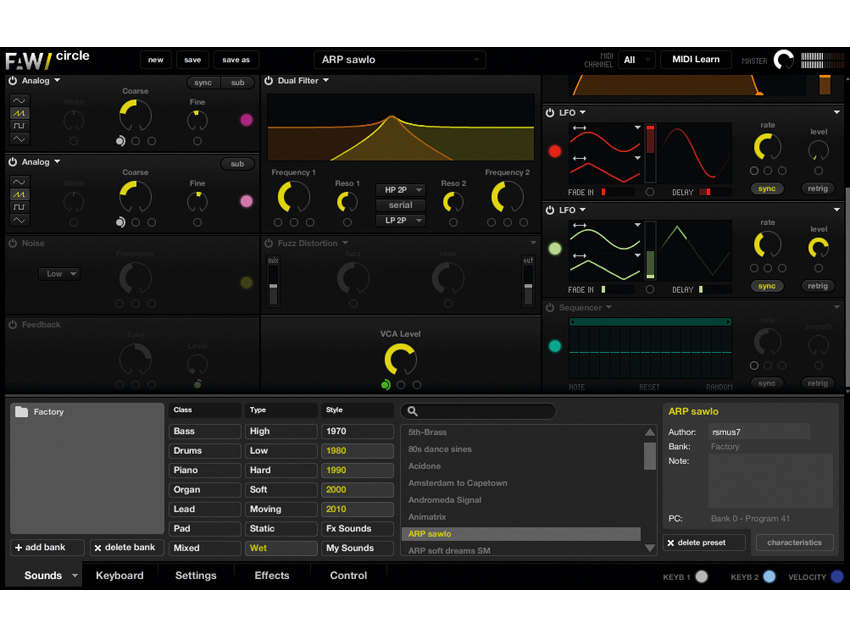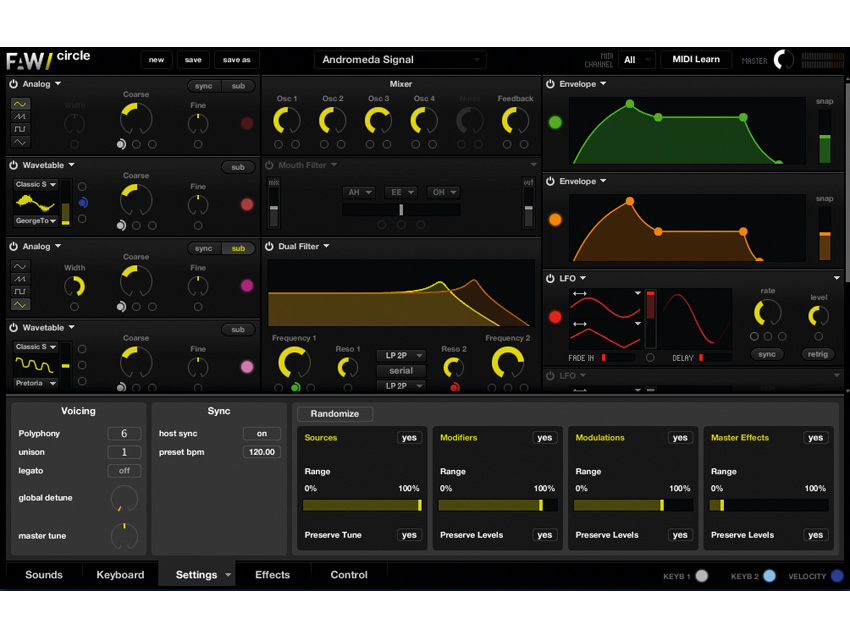MusicRadar Verdict
FAW has put serious effort into Circle´s interface so you don´t have to. Powerful synthesis has never been so accessible!
Pros
- +
Wicked wavetable oscillators. Elegant, intuitive design. Masterful, easy-to-use modulation. Righteous randomisation. Great, flexible GUI.
Cons
- -
Presets a bit lacking. Analogue oscillators can’t pump out multiple waves.
MusicRadar's got your back

FAW Circle

FAW Circle
Let's face it: modular synthesizers can be intimidating. The most mind-boggling of them offer multiple windows, graphical programming languages and virtual patch cables.
Simpler, so-called 'semi-modular' synths ditch the cables for the ubiquitous modulation matrix, but interrupting the creative flow to reroute some modulation or another can be a serious buzz kill.
With Circle, Future Audio Workshop has recognised this dilemma and attempted to rectify the situation. Its take on modulation eschews virtual cables, modulation matrices and other common paradigms.
Circle is a cross-platform synthesizer that's available in VST, AU and RTAS formats. The instrument's charcoal GUI takes the form of a split-horizontal playing field of the sort popularised by Live and Logic 8. A handful of tabs at the bottom call up further panels, including Sounds, Keyboard, Settings, Effects and Control editors.
This system is tidy and logical, and you quickly realise that an intelligent approach to design has been applied to the entire instrument.
Oscillators
Circle is a semi-modular synth with four oscillators. Analogue or Wavetable modes are selectable for each.
Analogue waveforms include sine, saw, square (AKA pulse) and triangle, with tuning and pulse width controls. Oscillators 1 and 3 can be synchronised to 2 and 4 respectively.
We wouldn't have minded being able to select multiple waveforms for each analogue oscillator, but the extensive wavetable ones make up for this omission.
Speaking of which, rather than piling a bunch of ROMpler-style samples of real instruments into its wavetables, FAW has taken the more creative approach - its waveforms recall the glory days of early wavetable instruments like the Sequential Circuits Prophet-VS.
There are 109 waveforms available, and the sounds they yield are electronic to the core and delightfully digital. You can choose two waveforms per oscillator and morph between them using a slider, MIDI or modulation source.
In addition, there's a noise oscillator with adjustable frequency and a tuneable Feedback oscillator that routes the instrument's VCA back to the input after passing it through a delay line.
Effects and filter
All of the above sound sources are mixed and sent through an effects processor, a filter and another effects unit, in that order. Available effects range from a vowel filter and EQ to ring modulation, fuzz, phaser and more - they're all thoroughly modern and sound excellent.
The filter is sandwiched between the twin effects slots and you can select between single- and dual-filter routings. The usual low-, high- and band-pass filters in both two-pole and four-pole variations are present, and the sound is modelled on that of the Sequential Pro-One.
Modulation
Each of Circle's five modulation slots sports a different colour and can be occupied by a four-stage envelope generator, an LFO or a sequencer.
The LFO is especially nice, offering 16 waveshapes, and as with the wavetable oscillators, you can morph between two selected waves. Cooler still is the fact that the current position is reflected in real-time, so, for instance, when you play a new note, a small dot traces along the contour of any active envelopes.
This will be of particular help to those who are new to synthesis, but whatever your level of expertise, actually being able to see your LFOs, envelopes and sequences moving is undeniably valuable.
Setting up modulation routings is child's play. As mentioned, each potential mod source is assigned a colour-coded circle (hence the synth's name), and these can be dragged to any of the destination circle slots that appear under knobs, sliders and so on. It's a bit like the drag-and-drop system of NI's Massive, but a lot easier to get a grip on due to the colour-coding.
Furthermore, if you drag but don't drop a mod circle over a destination, you can play away and hear how that modulation would sound, enabling you to audition many possible routings before plumping for the one you like. Brilliant!
As mentioned earlier, the regular oscillators themselves are also modulation sources, and can operate at audio rate (useful for FM and AM effects) or at LFO speeds when the Sub button is activated.
Summary
Some synthesizers come out of the gate with all bells, whistles and sirens screeching out a mega-blast of hyperbole and promising all kinds of futuristic, far-out tones, but Circle isn't that kind of instrument.
It's probably not going to replace your favourite ROMpler or classic hardware clone, and after a poke around the factory presets, we were a little disappointed. Many do little to show off Circle's potential, and of those that take advantage of the routing possibilities, too many are unmusical.
However, FAW has made it so easy to achieve good sounds that this isn't necessarily a deal-breaker - it's more the case that Circle is just waiting for the right synthesist to come along and load it up with some more exciting patches.
So, we weren't blown out of our chairs, but neither were we left scratching our heads. And if you like your synths to sound synthetic, Circle has your name all over it.
Hear Circle do its thing in these audio clips:
Computer Music magazine is the world’s best selling publication dedicated solely to making great music with your Mac or PC computer. Each issue it brings its lucky readers the best in cutting-edge tutorials, need-to-know, expert software reviews and even all the tools you actually need to make great music today, courtesy of our legendary CM Plugin Suite.
“We were arguing a lot and we were miserable”: How Green Day exceeded expectations with their most ambitious song
"There’s plenty for us guitarists to learn – and ‘less is more’ is the overriding lesson": how to play like George Harrison on The Beatles' Abbey Road
“They didn’t like his bikini underwear”: Prince’s support sets for the The Rolling Stones in 1981 are remembered as disastrous, but guitarist Dez Dickerson says that the the crowd reaction wasn’t as bad as people think










